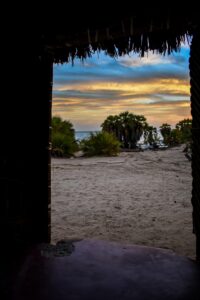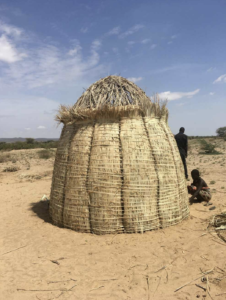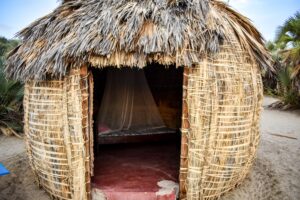Sleeping in the manyattas in Eliye springs

The Turkana tribe, found in Northern Kenya, have been predominantly harders moving from one location to another in search of greener pastures for their livestock. This has been common throughout Africa with communities living in desert-like areas. Due to this way of living, the type of houses they built for centuries has been a design that adapts quickly to the environment and is quick enough to set up and bring down due to changing seasons. The houses can easily be adapted for different seasons, alternating throughout the year between prolonged periods of drought and short periods of rain.

Turkana is an Arid to semi-arid area next to Lake Turkana, the biggest alkaline lake in the world. You will find sandy beaches and palm trees along the shores closer to the lake. The leaves of palm trees are dried out and used to form the roofing of the houses. For the structure, they use branches from shrubs. Branches from the Prosopis tree are dug into the ground to create a round frame which forms the walls. The branches are sewn together with sisal. During rainy seasons, cow dung would be used as a plaster on the walls to prevent water from getting inside the house. Still, the walls are usually left free to maximize air circulation since Turkana has temperatures as high as 35 degrees celsius throughout the year.

To experience sleeping in a manyatta, one can go to Eliye springs which lies right next to the shores of Turkana. The manyattas are designed true to the traditional ways, the only inclusion being a plastered floor and a bed in the room. The cool breeze from the lake makes the temperatures inside the house moderate throughout without needing extra fans or air conditioning.
